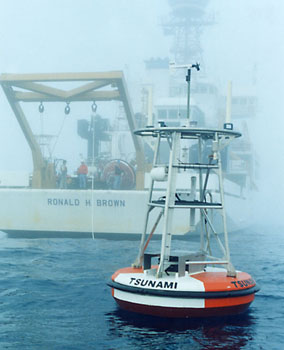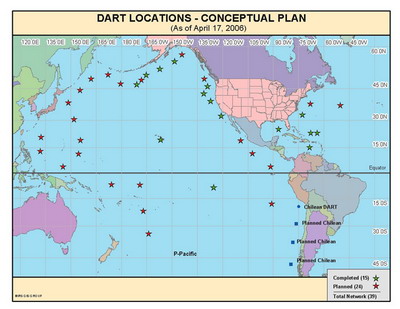Deep-ocean Assessment and Reporting of Tsunamis (DART)
Operational, real-time tsunami measurements
 |
The information collected by a network of DART systems positioned at strategic
locations throughout the ocean plays a critical role in tsunami forecasting. (Map from NOAA magazine, Apr 17, 2006) |
How the DART Network helps forecasting: When a tsunami event occurs, the first information available about the source of the tsunami is based only on the available seismic information for the earthquake event. As the tsunami wave propagates across the ocean and successively reaches the DART systems, these systems report sea level information measurements back to the Tsunami Warning Centers, where the information is processed to produce a new and more refined estimate of the tsunami source. The result is an increasingly accurate forecast of the tsunami that can be used to issue watches, warnings or evacuations.
| More information about DART |
DART buoy development: Over the past 20 years, NOAA's Pacific Marine Environmental Laboratory (PMEL) has identified the requirements of the tsunami measurement system through evolution in both technoloy and knowledge of deep ocean tsunami dynamics. The tsunami forecasting technology developed at PMEL is based on the integration of realtime measurements and modeling technologies, a well-tested approach used in most hazard forecast systems. Developed by PMEL and deployed operationally by NOAA's National Data Buoy Center (NDBC), DART is essential to fulfilling NOAA's national responsibility for tsunami hazard mitigation and warnings.
Design: The first-generation DART design featured an automatic detection and reporting algorithm triggered by a threshold wave-height value. The DART II design incorporated two-way communications that enables tsunami data transmission on demand, independenty of the automatic algorithm; this capability ensures the measurement and reporting of tsunamis with amplitude below the auto-reporting threshold.
